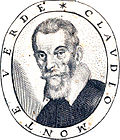Seconda pratica
Seconda pratica (Italian for "second practice"), also known as stile moderno, is a style of early Baroque music that emerged in the late 16th and early 17th centuries as a departure from the stricter rules of the earlier prima pratica or stile antico. The term was popularized by composer Claudio Monteverdi, who advocated for greater expressive freedom in musical composition, particularly in the treatment of dissonance and text setting. Seconda pratica emphasized the primacy of the words, allowing harmony and counterpoint to serve the emotional content of the text. This marked a shift toward modern expressiveness and helped lay the foundation for the development of opera and other dramatic vocal forms.
Overview
[edit]In the first part of The Artusi (1600), Artusi had severely criticized several unpublished madrigals of Claudio Monteverdi. In the second part of this work, L'Ottuso Accademico, whose identity is unknown, defends Monteverdi and others "who have embraced this new second practice".[1] Monteverdi adopted the term to distance some of his music from that of e.g. Giovanni Pierluigi da Palestrina and Gioseffo Zarlino and to describe early music of the Baroque period which encouraged more freedom from the rigorous limitations of dissonances and counterpoint characteristic of the prima pratica.
Stile moderno was coined as an expression by Giulio Caccini in his 1602 work Le nuove musiche which contained numerous monodies. New for Caccini's songs were that the accompaniment was completely submissive in contrast to the lyric; hence, more precisely, Caccini's stile moderno-monodies have ornamentations spelled out in the score, which earlier had been up to the performer to supply. Also this marks the starting point of basso continuo which also was a feature in Caccini's work.
In the preface of his fifth Book of Madrigals (1605) Monteverdi announced a book of his own: Seconda pratica, overo perfettione della moderna musica (Second Practice, or, Perfection of Modern Music). Such a book is not extant. But the preface of his eighth Book of Madrigals (1638) seems to be virtually a fragment of it. Therein Monteverdi claims to have invented a new “agitated” style (genere concitato, later called stile concitato) to make the music "complete/perfect" ("perfetto").[2]
References
[edit]- ^ Giovanni Artusi, Seconda Parte dell'Artusi, overo Delle imperfettioni della moderna musica, p. 16, Venice (1603)
- ^ Gerald Drebes: "Monteverdis Kontrastprinzip, die Vorrede zu seinem 8. Madrigalbuch und das Genere concitato", in: Musiktheorie, vol. 6, 1991, pp. 29-42, online: "Gerald Drebes - 2 Aufsätze online: Monteverdi und H. Schütz". Archived from the original on 3 March 2016. Retrieved 7 February 2015.
Further reading
[edit]- Foxon, Tim (2004). "Explain what Monteverdi meant by seconda pratica and show how this 'second practice' is reflected in three of his madrigals" (PDF). Musical Resources. Archived from the original on 11 December 2006. Retrieved 8 November 2006.
- Hanning, Barbara Russano. "General characteristics of Baroque Music". Chronology Baroque. iclassics.com. Archived from the original on 25 March 2021. Retrieved 8 November 2006.
- Excerpted from Hanning, Barbara Russano (1998). Concise History of Western Music (1st ed.). New York: W. W. Norton. ISBN 0-393-97168-6.
- Selfridge-Field, Eleanor (1990). "'Two Practices, Three Styles': Reflections on Sacred Music and the Seconda Pratica". In John Caldwell; Edward Olleson; Susan Wollenberg (eds.). The Well-Enchanting Skill: Music, Poetry, and Drama in the Culture of the Renaissance: Essays in Honour of F. W. Sternfeld. introduction by Sir Michael Tippett. Oxford: Clarendon Press. pp. 53–64.
